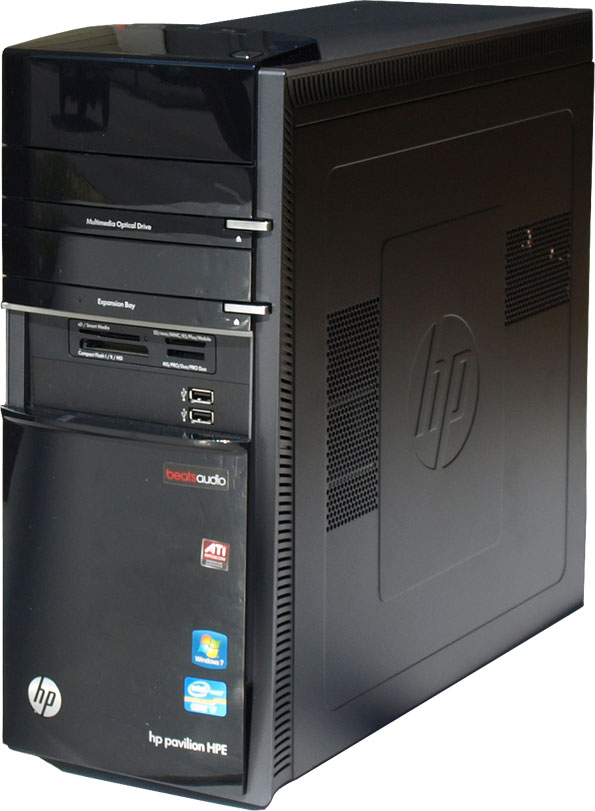Dell, HP, and iBuyPower Back-to-School PC Roundup
HP Elite Pavilion H8 1050 Design and Layout

HP's Pavilion H8 1050 ships in a compact box with a stylish albeit glossy exterior that's a bear to photograph (those aren't dents in the front panel, they're reflections). It's an attractive case that won't have any trouble blending in with a variety of decors, whether tucked away in a cramped dorm room or on display in a professional work office environment. Despite its compact size, HP doesn't intend for you to lug this around to LAN parties or back and forth across a college campus. It lacks a handle and doesn't have any molded spots to get a good grip.
Stealth is the name of the game here. A Blu-ray reader hides behind a glossy drive bay cover that automatically flips down when you eject the tray, and there's a sliding cover that slips down (manually) to reveal a multi-format media card reader and two USB 2.0 ports.

Stealth is the name of the game here. A Blu-ray reader hides behind a glossy drive bay cover that automatically flips down when you eject the tray, and there's a sliding cover that slips down (manually) to reveal a multi-format media card reader and two USB 2.0 ports.

On top are a pair of SuperSpeed USB 3.0 ports, a power button, and mic/headphone inputs. The ports are positioned so that they're hidden from sight if you're standing in front of the case. This design adds to the aesthetic at the slight expense of usability, in that you'll end up fumbling around trying to jostle your thumb drive into one of the USB ports.
Around the back you'll find:

Around the back you'll find:
- 4 x USB 2.0
- GbE LAN
- Optical SPDIF
- Audio inputs

OEMs have historically went to great efforts to keep bumbling customers from mucking around inside their PCs, but somewhere along the line, they figured out some of us actually know how to use a screwdriver. Some are better about it than others, and HP made it super easy to tear off the side panel, which is held in place by a single thumb screw. Once you toss the hunk of steel aside, however, your adventure is just getting started.
There's an obnoxious bar that stands in the way of easy access to the internal components and whose purpose appears to be to hold the graphics card in place. Or perhaps HP put the bar there to hide the jumble of cables that are strewn all over the place. On a positive note, the hard drive, CPU, and RAM all sit at the bottom and receive unobstructed access to air flow, so the messy cable management ultimately amounts to little more than an eyesore, and one that's not visible with the window-less side panel in place.
Notice that the motherboard is attached to the left side of the case, which requires removing the right side-panel. Most ATX systems are the exact opposite.
There's an obnoxious bar that stands in the way of easy access to the internal components and whose purpose appears to be to hold the graphics card in place. Or perhaps HP put the bar there to hide the jumble of cables that are strewn all over the place. On a positive note, the hard drive, CPU, and RAM all sit at the bottom and receive unobstructed access to air flow, so the messy cable management ultimately amounts to little more than an eyesore, and one that's not visible with the window-less side panel in place.
Notice that the motherboard is attached to the left side of the case, which requires removing the right side-panel. Most ATX systems are the exact opposite.






